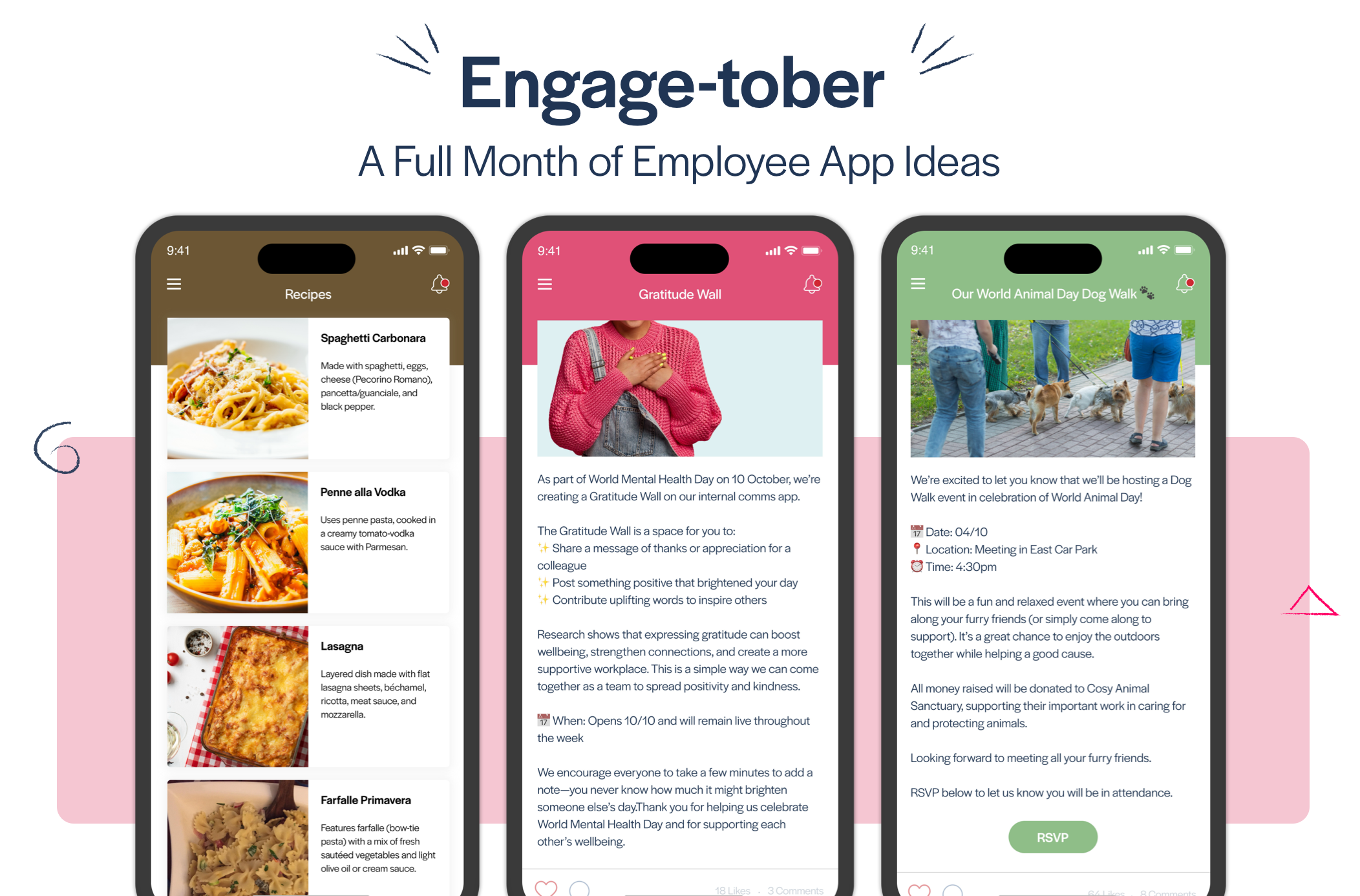
Blog
Do Employees Really Care About Internal Comms?
Our Client Success Manager explores the importance of having an ‘operational hook’ in your employee communications app.

In this blog post, I’ll explore the importance of having an ‘operational hook’ in your employee app – something that solves problems for your employees, instead of just solving a problem for you as an internal comms person. Starting with the assumption that your employees want to read your internal communications is a first step on the wrong foot. You need to offer a little more than that.
Here’s a question that you probably don’t want to know the answer to:
“Do employees actually want to receive internal communications?”
I spend a lot of time reading internal comms blogs, trying to find some key insights to share with our customers: lots of stuff about internal comms being the key to happy and productive employees. Your employees are all out there, just begging to know more about company strategy and your CEO’s goals for the coming year, and if they could only have some visibility of your latest marketing initiative, they’d totally buy in and be a real advocate for the business… yeah, as if.
The problem with this kind of thinking is that it assumes that all your employees want to receive internal communications. Now don’t get me wrong, I’m sure that lots of them do – some are really engaged and they want to stay up to date with what’s happening.
The truth though? A lot of them don’t really care all that much.
I mean, if you’re in a really cool tech startup in Silicon Valley, you’re probably seeing a bigger portion of naturally ‘bought-in’ employees who want to know what’s going on. Working in a large retail store in a commercial park in Stoke? Maybe less so. The big problem here though, is that those people who don’t care that much – the employees in remote sites or working from home, are the people that you’re so desperately trying to reach.
It’s important to realise though, that engagement and involvement are not the default position for most people. The default is doing nothing. As Christopher Hunsicker of the Harvard Business School remarks:
While a 2019 Gallup poll reported that while employee engagement is on the rise, only 34% of US employees consider themselves to be engaged. Again, the benefits of an engaged and informed workforce are huge – better retention and productivity included, but it’s not ‘normal’ or the default for most people.
This is the scary truth that a lot of internal comms practitioners shy away from. For most, the default is simply to come in to work, do your job, scroll through Twitter for ten minutes on lunch break, go home, and switch off until tomorrow. This is the key issue that I have with a lot of the internal comms advice out there – it assumes the opposite, that if you just give employees an internal comms channel, and make really engaging content, their natural pre-disposition ‘to be engaged’ will win the day. It’s just a surefire way to only ever get about 30% of your employees engaged. You need to give the shoulder shrugging and uncaring majority a little bit more if you want them to engage with you, use your app, your intranet, or whatever you’re asking of them. Because that’s exactly what it is – an ask. And what are they going to ask back? “Why would I use that? What’s in it for me?”
The solution is to start thinking about your internal comms role not just as a way to solve a problem for the business, or for you (“We need to let employees know about this thing that’s happening”) but to start thinking about how you can solve problems for the employee too.
At Thrive, we make Employee Apps, so that’s the example I can use the illustrate the point best. Over the last few years, I’ve seen companies struggle to engage with a remote and disconnected workforce, and doing everything ‘right’ in terms of content creation, launch and promotion of their apps – but never really break through the 30-40% usage number. But what problem does it solve for employees? Are you really giving them a good reason to use it? Remember, the default is non-participation, non-engagement. Your employees are not going to get onboard with something like an employee app unless you give them a reason to, by solving a problem for them. That could be allowing them to complete a task more efficiently, finding information that they’re previously struggled to find… whatever it is, it’s not likely that you’ll know without asking the relevant people.
I talked a bit about this in a previous blog post, where I highlighted the importance of getting out among your staff and talking to them before deciding to go ahead with something like an employee app.
If you’re not out there talking to people and finding out what problems need to be solved, then you’re only really focusing on the problem that you need to solve. You need a vehicle for sending out communications to employees – that’s your problem. But your employees are not coming along for the ride unless it does something to solve their problems too. Starting a project for an employee app, or any new channel for communications or engagement, without doing some research in to the problems you can help to solve for employees – it’s a one-way ticket to low usage and poor engagement. It’s just ‘the business’ throwing something out there to see what sticks.
So how do you ask these questions and find out what problems you might be able to solve for employees? Aside from talking to the employees themselves (which you should absolutely be doing!) the answer very often lies in ops. The operations managers are usually the people who spend all day solving problems and dealing with employee’s requests. Ask some simple questions like:
“We’re thinking about getting an employee app for internal comms, are there any operational-type tasks or time-savers that would really help you out?”
It’s all about embedding these operational tasks in your app to give your employees a good reason to use the it. Those things might even become the main reason for them using the app, but as long as they have it installed and they keep coming back, they’ll also be seeing your internal comms content, and you’ll be able to reach them with push notifications.
Like I said above, most employees don’t particularly want to engage, but they will if you give them a good reason to and if you’re thinking about the overall employee experience, rather than just solving your own internal comms problem from your own internal comms silo.
When you’re approaching employees and you’re talking to people from ops, what you’re doing is trying to uncover lots of pain-points. What are the annoyances? What takes way longer than it should? Are you wasting loads of time filling in these forms and dropping them in somewhere?
And if you can start to uncover those problems to be solved, you can very quickly start to ask questions like: “What would that be worth to the business?” And that’s how you start to make a more solid business case for your (in this case) employee app project. Make an effort to solve your employees problems and annoyances, or at the very least use the app as a way to make their day a little bit easier.
Your app doesn’t have to be the ‘be all and end all’ of business automation and save the business ten million dollars a year. It just needs to have an operational hook – a reason for employees to download it, and to keep using it. Without that, you’re limiting yourself to reaching only the super-keen and naturally enthusiastic minority.
Here are a few examples of what a few of our other customers have done to add an operational hook in to their apps. As you’ll see, it’s nothing life changing – it just addresses employees’ pain-points and crucially, gives them a reason to open the app.
Springfield Healthcare – Forms for Common Tasks
Springfield operate care homes in Yorkshire, England and have around 1500 employees. From talking to employees, they found that people were spending a lot of time printing out, filling in, and delivering all of the various forms that need completed in their daily work. Some of these forms are for carrying out checks on residents, or completing an accident report, while others are for requesting holidays or referring friends for jobs.
With their MySpringfield app, alongside their internal comms, user generated content and engagement content, they’ve decided to digitise most of their operational forms so that their employees can complete them in the app, and they’ll automatically be sent to the appropriate department on completion. They’ve combined this with our user groups feature so that each employee will only see the forms that are relevant to them. It saves loads of time, makes people’s jobs easier, and as environmental benefits from not printing so much paper!

Biffa – Making it Easier to Access Payslips
This is a really simple and obvious one, but if you have an online portal that your employees can use to access their payslips, then rather than them having the remember the link, you can serve it via your app. Biffa have added the URL for their payslip portal as a ‘Web Page’ on their app’s homescreen so that their employees can log in to check that they’ve been paid correctly. Do you have a portal for payslips? Add it to your app to make life easier for your employees! If you use the ‘Open link in external browser’ option when adding the webpage, the phone’s browser will offer to save the username and password, so that they don’t have to enter it every time they want to check the payslip.

Port of Tyne – Making staff rotas and internal phone book available everywhere
The Port of Tyne serve their rotas using a web page that’s only available when you’re on-site and connected to their network. Using our ‘Secure Browsing’ feature, the rotas and their internal phone book have been made available to employees at home, through their employee app. Secure Browsing is a bit like a proxy, where it sends the request via the Thrive server, so that the restricted web page can be accessed through the app, even if it isn’t connected to Port of Tyne’s network. This is a huge improvement to quality of life for employees, who can now check their rotas from home, instead of only being able to access them on-site. It’s valuable to the business too, offering greater efficiency by replacing alternative paper-based systems.

We notice that clients with operational hooks in their apps average 50-60% and above usage, versus those relying soley on internal comms content struggling to break through the 20-30% level. Have a think about some of the processes in your business, how people request holidays, get their rotas, etc, and contact me at ian.mccutcheon@thrive.app to discuss adding operational hooks into your app and increasing your app usage.









